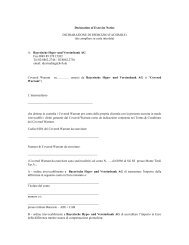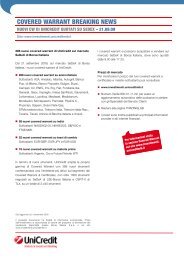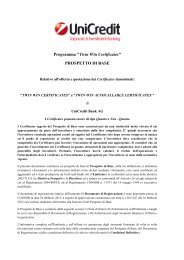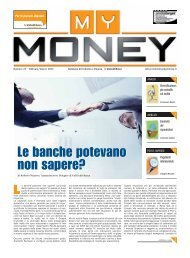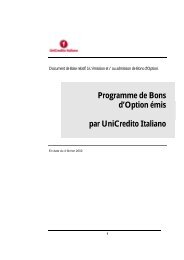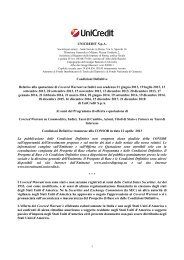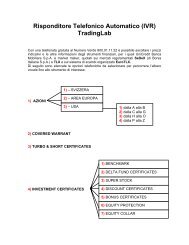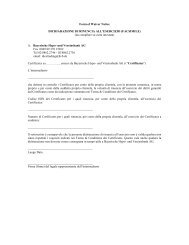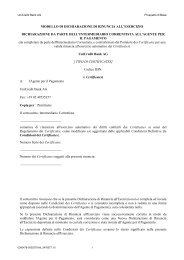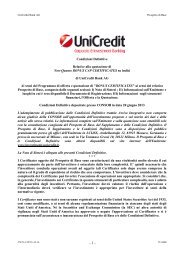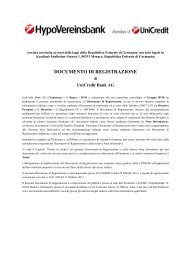UniCredit Bank AG
UniCredit Bank AG
UniCredit Bank AG
You also want an ePaper? Increase the reach of your titles
YUMPU automatically turns print PDFs into web optimized ePapers that Google loves.
Financial Statements (2) | Consolidated Financial Statements<br />
Accounting and Valuation (CONTINUED)<br />
As part of hedge accounting for credit risks, the credit-induced changes in the fair value of a hedged item and the full-induced changes in the fair value of<br />
a hedging instrument are offset. Remaining-term effects need to be adjusted in this context.<br />
These remaining-term effects lead to a change in the credit-induced fair value over time without the current market credit spread changing. Among other<br />
things, this includes a difference between the nominal amount and the credit-induced fair value at the inception of the hedge. Excluding the possibility of<br />
an impairment, the credit-induced fair value on the settlement date will correspond to the nominal amount of the hedged item. Any difference between<br />
the credit-risk-induced fair value and the nominal amount existing when the hedge is designated amortises over the remaining time (pull-to-par effect).<br />
Differences like this can arise when hedged items are designated at a later date rather than when originated, for instance, since the contractually agreed<br />
credit spread does not generally match the normal market credit spread at the inception of the hedge in such cases.<br />
The change in the credit-induced fair value determined in this way (after adjustment for remaining-term effects) is taken to the income statement under<br />
effects arising from hedge accounting in net trading income. Where the hedged items are assets recognised in the balance sheet, the carrying amount is<br />
adjusted for the changes in the credit-induced fair value. Irrevocable credit commitments (fixed commitments not shown in the balance sheet), on the<br />
other hand, are not recognised in the balance sheet. The credit-related changes in the fair value relating to these are carried under other assets in the<br />
balance sheet.<br />
We show the associated hedging instruments at their fair value as hedging derivatives; the changes in the fair value are similarly taken to the income<br />
statement as effects arising from hedge accounting in net trading income.<br />
The hedge is terminated compliant with IAS 39.91 if either the hedging instrument or the hedged item expires, the hedge is no longer efficient or the<br />
<strong>Bank</strong> decides to terminate the hedge.<br />
When the hedge is terminated, the credit-induced changes in the fair value accruing to that date with regard to the hedged risk (hedge adjustment) are<br />
amortised over the remaining term of the hedged item. This amortisation is disclosed in net interest income. If the hedged item similarly expires upon<br />
termination of the hedge exceptionally (in the event of early repayment by the borrower, for instance), the hedge adjustment accruing to that date is taken<br />
directly to the income statement.<br />
If the hedging instrument does not expire at the end of the hedge, it is designated as held for trading and continues to be recognised at fair value under<br />
net trading income.<br />
8 Assets held for trading purposes<br />
This item includes securities held for trading purposes and positive market values of traded derivatives. All other derivatives not classified as hedging<br />
derivatives (which are shown separately in the balance sheet) are similarly considered held for trading. This includes standardised credit default swaps<br />
(CDSs) concluded outside the held for trading portfolio, which are measured in the same way as traded derivatives.<br />
Provided they are held for trading purposes, promissory notes, registered bonds and treasury bills are carried as other financial assets held for trading.<br />
Financial assets held for trading purposes are carried at fair value. Gains and losses arising from the valuation and realisation of financial assets held for<br />
trading are taken to the income statement as gains less losses arising from trading securities.<br />
9 Financial assets at fair value through profit or loss<br />
HVB Group mainly applies the fair-value option for financial assets with economic hedges for which hedge accounting is not applied. The designation<br />
removes or significantly reduces differences resulting from an accounting mismatch. The portfolio mostly comprises interest-bearing securities not held<br />
for trading that are hedged against interest rate risks by means of interest rate swaps. In the case of promissory note receivables similarly included here,<br />
there is no material fair value change in terms of the credit risk on account of the top rating of the issuers. Changes in fair value of the hedged items and<br />
the associated derivatives are shown separately in net trading income; current interest income/expenses are recognised in net interest income. Alongside<br />
an accounting mismatch as the main grounds for designation, the designation for a specific, smaller portfolio is based on fair value-based risk management.<br />
F-17<br />
104 2009 Annual Report · HypoVereinsbank




